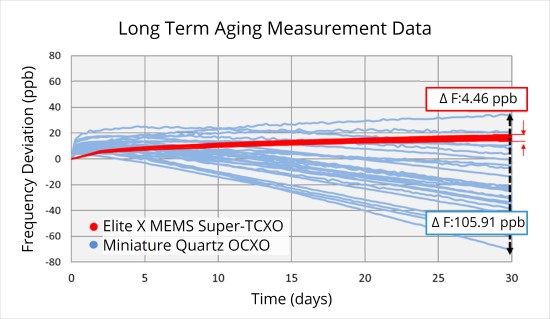Why Precision Timing Holds the High Ground Over Quartz (Part 1 of 2, Hardware)

As AI and machine learning launch us into the 4th industrial revolution, engineers are taking a fresh look at how data transmission gets synchronized through electronic systems. More data is traveling at faster rates through greater levels of system complexity. Accurate, low jitter and stable timing signals are crucial for synchronizing the data flow. To meet the demands of emerging technology and keep systems running like clockwork, it’s time to rethink your timing devices. In this two-part Precision Timing series, you will learn why micro-electro-mechanical systems (MEMS) silicon timing devices take the high ground over quartz in the new age of electronic design.
The Difference Between Quartz and MEMS Materials and Why You Should Care
Silicon is the core material used in MEMS timing devices. It is made from ultra-pure single-crystal silicon, or monocrystalline silicon. Single-crystal silicon has a clearly defined crystal structure for consistent and reliable performance. In fact, SiTime silicon MEMS devices have 50X greater quality and reliability over quartz crystal devices in the same class with less than 1 defective part per million (DPPM) compared to quartz failure rates of 50 DPPM or more.
Quartz crystal can also be a pure material, but it naturally contains aberrations—defects that don’t occur in single-crystal silicon. In addition, quartz crystals need metal electrodes and are attached with epoxy glue. These materials are not as reproducible and well controlled as single-crystal silicon.
Another point of differentiation is size and mechanical resilience: competing devices made of quartz are larger than their MEMS silicon counterparts. In fact, SiTime silicon MEMS resonators at 32 kHz are up to 1,000 times lighter and smaller than competing quartz resonators. Due to the larger size of quartz devices, mechanical g forces have a much greater impact, making the quartz devices more sensitive to shock and vibration. Differences in material strength—mass and construction—make quartz timing devices prone to crack or break more easily than MEMS silicon under shock.
SiTime MEMS timing devices use standard semiconductor processes facilitating miniaturization and easier integration into electronic systems. The silicon MEMS material enables better quality, streamlines manufacturing and promotes economies of scale previously unattainable with quartz.
Resilience: Enduring the Toughest Conditions
MEMS resonators provide exceptional resilience. Their solid-state nature and structural design render them highly resistant to environmental stressors such as vibration, shock, temperature changes, high pressure and humidity.
MEMS oscillators are more resilient to temperature changes. Because the resonator is made from silicon, it can be mounted directly onto the oscillator IC or paired together on the same substrate with a temperature sensor, eliminating the distance between elements and making temperature compensation dramatically more effective. This durability ensures MEMS-based timing solutions maintain their accuracy and reliability under conditions that would degrade quartz oscillators' performance, offering a more robust solution for critical applications.
Epi-Seal Process: The Manufacturing Marvel
A standout feature in the manufacturing of SiTime MEMS devices is the Epi-Seal® process, a proprietary fabrication method that encapsulates MEMS resonators in a pure-silicon, clean vacuum environment. This innovative sealing method protects the resonator from environmental contaminants and significantly enhances the device's long-term reliability and performance. The ability to create a hermetic vacuum seal at the wafer level is a departure from traditional quartz crystal resonator manufacturing, where enclosing the resonator is performed at the package level, introducing the potential for variability, impurities, contamination and defects.
Contaminants within the resonator cavity have a major impact on oscillator frequency stability, especially long-term frequency deviation over time, called frequency aging or drift. The Epi-Seal process enhances the reliability and longevity of SiTime’s MEMS devices over competing solutions, preventing frequency aging.

Long-term frequency deviation of SiT5501 MEMS Super-TCXO (red) versus miniaturized quartz OCXO (blue).
Scaling and Integration: Silicon's Supply Chain Synergy
Silicon wafer fabs (fabrication facilities) operate on standardized processes, unlike the more specialized and less flexible manufacturing operations required for quartz oscillators. Because of this, silicon-based MEMS oscillators can help you streamline your supply chain for your electronic systems, offering more predictable and shorter lead times than quartz device manufacturers. This translates into improved supply chain agility for procurement managers, enabling scalability and faster time-to-market for new products.
Quartz oscillators use a distinct quartz-based resonator combined with an oscillator chip, which are packaged together in a ceramic or metal package. MEMS-based oscillators combine a silicon MEMS chip with an oscillator chip. But because the MEMS resonator is sealed within silicon and because both chips are silicon, they can be packaged together in a standard semiconductor package such as plastic quad flat no-lead (QFN) or use more advanced semiconductor packaging technologies such as wafer-level chip-scale packages (WL-CSP) to further reduce footprints. Because of this, MEMS timing chips are easier to integrate into the greater system and can reduce board space, leading to design efficiencies in power, performance, and area (PPA).

SEM image of WL-CSP silicon MEMS oscillator, showing a silicon MEMS resonator mounted directly onto an oscillator IC.

SEM image of cross section of SiTime MEMS resonator.
Manufacturing the Future of Timing
The Epi-Seal process exemplifies SiTime’s commitment to being the leader in MEMS precision timing. By encapsulating MEMS resonators in a pure-silicon, clean vacuum environment, SiTime ensures superior reliability, stability, and longevity for its devices, outperforming conventional quartz solutions. Moreover, the integration of silicon-based MEMS oscillators into standardized wafer fabrication processes offers significant advantages in terms of supply chain efficiency and scalability. As the demand for advanced electronic systems continues to grow, SiTime’s innovations provide a compelling solution that meets the needs of modern technology while paving the way for future advancements.
For more information, check out part 2 of this series at Why Precision Timing Holds the High Ground Over Quartz (Part 2 of 2, Programmability).